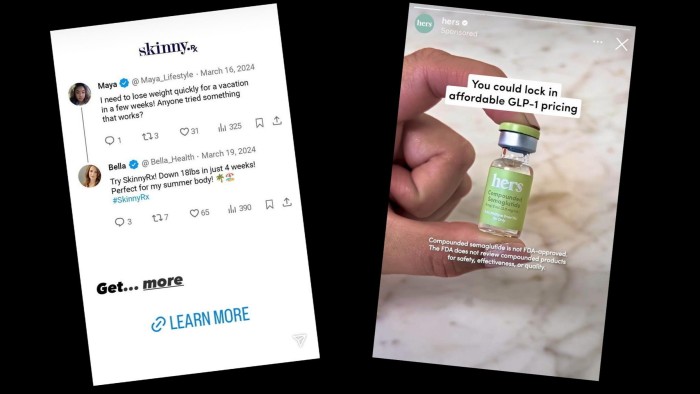Unlock the Editor’s Digest for free
Roula Khalaf, Editor of the FT, selects her favourite stories in this weekly newsletter.
In one hand, a slender young woman holds up a bottle of clear liquid. The words “Skinny” and “GLP-1” — a new class of weight loss drugs — are visible on the label. In the other hand, she raises up a pipette filled with the liquid, as if to drop it in her open mouth. “Lose up to 15% of your body weight,” reads the caption on the Instagram post.
The marketing, from a little-known online pharmacy called Skinny Rx, is one of thousands of advertisements that are targeting young women on social media, promising users they can get their hands on “affordable” anti-obesity or anti-diabetic medications in just a few clicks.
In recent weeks, I’ve found my own Instagram feed taken over by the adverts despite never having purchased the drugs. Up to eight consecutive ads will appear for weight loss pills, oral liquids or injectables.
Looking on Meta’s Ads Library, it’s clear I am not the only one. There are more than 5,000 active adverts listed that contained the phrase GLP-1, plus more than 3,100 campaigns that mentioned the GLP-1 drug “semaglutide” and over 4,000 referencing “Ozempic”. As a comparison, popular beauty product terms, such as nail polish and blusher, featured in fewer ads — around 3,000 and 1,100 respectively.
The value of these drugs in treating obesity and diabetes is clear. And marketing for legitimate prescription medications is legal here in the US. But allowing people to be bombarded with advertising that promotes rapid weight loss — at a time when social media platforms face increased pressure to take more responsibility for the content shown to users — is irresponsible, say experts.
Dozens of studies have already found strong links between photo and video-centred social media and eating disorder pathology. In 2021, whistleblower Frances Haugen leaked Meta’s own research suggesting Instagram can be detrimental to the mental health of some teenage girls. One memo showed that an Instagram employee had posed as a 13-year-old girl seeking diet tips, only to be served recommendations of accounts called “skinny binge” and “apple core anorexic”.
Silicon Valley companies are aware that change is required. In January, Meta announced that it would restrict teenagers from seeing content around disordered eating. But weight loss drug adverts for over 18s are permitted on the platform.
The proliferation of this marketing “could open up eating disorders, or maybe the person already has an eating disorder, and then it gets into a really self-harming drive,” said Maria Rago, president of The National Association of Anorexia Nervosa and Associated Disorders.
In addition to touting a low price point, the messaging in many adverts suggests users can easily get their hands on the drugs, despite the requirement that they be prescribed and dosed by a doctor.
One advert, when I clicked on it, would have allowed me to instantly buy an Ozempic alternative. For another, I was asked to fill in a questionnaire, adding my height and weight. By simply tweaking the numbers, I was immediately “preapproved” for the drugs.
Some adverts also peddle so-called “compounded” semaglutide products — custom-made medications not approved by the US Food and Drug Administration regulator. “Those [adverts] are more scary to me,” said Rago, noting that they could be unsafe.
There are limitations. Meta’s policies prohibit ads that “generate negative self perception” or “exploit insecurities to conform to certain beauty standards”.
In Australia and the UK, adverts for prescription drugs are already banned. TikTok does not allow weight loss drug ads. In the US, the Senate introduced a new bill in September targeting misleading prescription drug ads.
If no further restrictions are forthcoming, McKenna Ganz at The Eating Disorder Foundation hopes social media users will not be persuaded to buy drugs just because they see glamorous ads. “That’s a decision they should be making with their own physicians,” she said. “And not just basically in collaboration with the social media algorithm.”
Read the full article here

